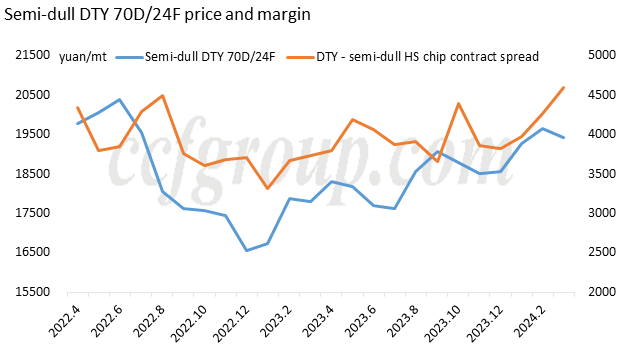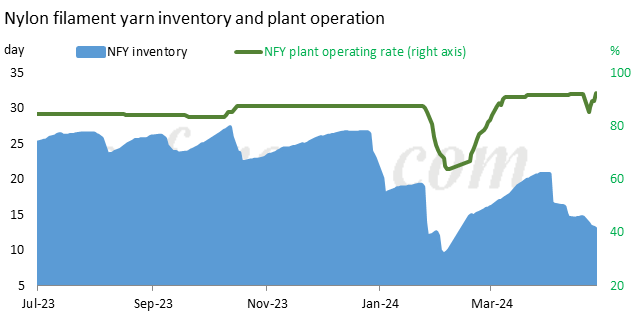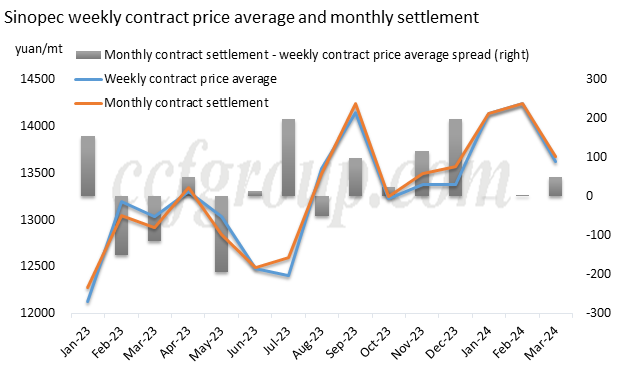Nylon filament profit improvement temporary or trending
1. Profit improvement across nylon filament market
Since January 2024, filament plants have seen a continuous improvement in profits, mainly due to pricing adjustments following raw material fluctuations and the effective avoidance of low-price loss risks.

Taking nylon 6 dull FDY 70D/48F as an example, demand for sun-protective clothing had surged from March to May 2023, causing a supply shortage and pushing the processing fees to high levels around 3800-4000yuan/mt (with cost reference of dull HS chip contract). As supply increased significantly and the production peak season transitioned, processing fees gradually fell to a rational range of 3100-3400yuan/mt. Despite some demand fluctuations in the second half of the year, overall demand remained strong, but it was challenging for processing fees to continue rising. In 2024, although demand did not reach the expected levels of the previous year, processing fees gradually increased to around 3500-3900yuan/mt.
Note: The processing fees hereinafter are margins required by filament producers based on nylon 6 high-speed spinning (HS) chip.

Looking at semi-dull DTY 70D/24F, the most challenging period in recent years was the second half of 2022 when there was an oversupply and intense competition, with the processing fees compressed to 3500-3800yuan/mt, with some even below 3300yuan/mt (processing fees: using contract semi-dull yarn slices as a reference for raw material costs). In 2023, as demand recovered, processing fees gradually rose to around 4300yuan/mt; in the second half of 2023, the sustained improvement in demand for many high F-spec DTY yarns and increased production of semi-dull 70D/24F switched led to a tightening supply, but processing fees did not increase further. By 2024, although the peak season demand did not match the previous year's intensity, the overall supply remained tight, pushing processing fees up to around 4500-4600yuan/mt.
In 2023, filament plants saw strong production and sales, but the alignment of nylon filament processing fees with demand intensity was not perfect. This was mainly due to the cautious approach of manufacturers in the first year after the pandemic restrictions were lifted. While the market seemed to be recovering strongly, it was relatively fragile and sensitive, with manufacturers primarily focused on maintaining production levels and market share. In 2024, although demand was not as hot as the previous year, processing fees increased significantly. The consistency in the increase of processing fees in the industry was mainly due to favorable supply and demand conditions in phases and a shift in mindset.
2. Periodical favorable supply and demand structure

Although the peak season demand in 2024 is lower than expected, filament plants have managed to gradually reduce their accumulated inventory from the high production levels during the Chinese New Year holiday period in March and April. The industry is currently operating at around 92%, with downstream stocking activities not very aggressive. Despite this, filament plants' inventory has returned to relatively low levels. This indicates that while downstream demand has not exploded as it did in the same period last year, it remains stable and showed growth.
Filament plants faced no pressure in terms of sales, leading to a shift in their cautious mindset. They are no longer as cautious as they were last year and have collectively agreed to increase processing fees to reflect the tightness in their product supplies. In March and April 2024, processing fees for various product specifications increased by 200-500yuan/mt, depending on the degree of supply tightness for each product.
The improved profitability of filament plants is not only due to the increase in processing fees but also the enhanced predictability of contract raw materials. This enhancement allows filament plants to adjust prices more effectively, reducing the risk of losses and increasing profit margins.
3. Enhanced predictability of costs and further reduction in pricing risks

Note: The average weekly contract price in the above chart is calculated as a simple arithmetic average based on the published weekly pre-sales prices, without considering the actual monthly settlement announced by Sinopec. This is primarily to illustrate the deviation between the reference price for raw materials when pricing at filament plants and the actual cost price, and its impact on the profitability of filament plants.
Since filament plants mainly use contract raw materials, their pricing is also mainly based on Sinopec's contract settlement for CPL. In 2023, Sinopec introduced a weekly pricing model, which improved the predictability of the monthly settlement. However, the evaluation of the contract price for the final week of each month remains uncertain, leading to a deviation of up to 200yuan/mt between the average weekly prices and the actual monthly settlement. This discrepancy between the reference cost used for pricing and the actual cost impacts filament plants' profitability, as they cannot estimate this deviation in advance and adjust their pricing accordingly.
However, in 2024, Sinopec's CPL settlement model has been further optimized, significantly narrowing the gap between the average weekly pricing and the monthly settlement. This enhancement in cost predictability has allowed filament plants to adjust prices more effectively based on expected monthly settlements, avoiding deep price falls and controlling low-price orders. For example, in April, although Sinopec's CPL had consecutive weekly prices of 13020yuan/mt and 13120yuan/mt, but the market expected a rise in CPL April contract settlement. Most filament plants priced their products based on a CPL of 13200-13300yuan/mt to avoid the risk of losses from accepting low-price orders. When the contract CPL rose to 13600yuan/mt, filament plants adjusted their prices accordingly. Over time, with synchronous price increases and not synchronous deep price falls, filament plants' profit margins expand.
4. Improvement in profits, temporary or trending?
Due to the steady growth in demand and limited new nylon filament production capacity, it is expected that there will be no immediate downward pressure on the processing fees. Additionally, the predictability of contract raw material prices continues to benefit filament plants in risk mitigation and profit enhancement. The greater the fluctuation in raw material prices, the more flexibility filament plants have in their operations. Therefore, during the current peak demand season and with few new spinning projects, filament plants are expected to maintain a good profit margin.
- Top keywords
- Cotton Price
- Cotton Futures Price
- Cotton Futures
- CZCE
- PTA Futures Price
- Chemical Fiber
- Polyester Prices
- Wool price
- PTA Futures
- Shengze Silk
- China
- Yarn Price
- price
- China Textile City
- Fibre Price
- Benzene Price
- Cotton
- Index
- Cotton Index
- PTA
- fabric price
- NYMEX
- Top 10
- textile industry
- Spot Cotton
- Cotton Yarn
- Polyester Price
- Futures
- PTA Price
- cotton yarn price

